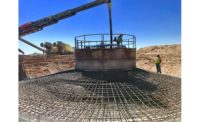Q&A: Tim Maag of Mortenson Talks Wind Power

Tim Maag is vice president and general manager of Mortenson's Wind Energy Group.
Photo courtesy of Mortenson
Tim Maag is vice president and general manager of Mortenson's Wind Energy Group, and has led more than 75 wind projects totaling more than 11,000 MW of electricity. We talked with Maag about the trends he is seeing in the growth and development of wind energy, and the rapid changes in the renewable energy industry.
Engineering News-Record: How has the construction of wind farms changed over the last decade? Are there new technologies or methods that make the construction of wind farms easier or better?
Tim Maag: In certain respects, its gotten more difficult for contractors. Many of the easy sites have already been constructed and the available sites are often more challenging. Everything is also getting bigger: Cranes are getting bigger and have to be bigger to accommodate larger turbines. When you have larger turbines, instead of being able to complete the assembly of certain components (nacel, as an example) in a controlled environment, they must be shipped in pieces and assembled onsite. Some Wind farms are also being built farther way from [the] point of interconnect too, which requires more transmission lines.
ENR: Does Mortenson self-perform construction?
TM: We self-perform the majority of the work ourselves. We self-perform the site work, concrete foundations, turbine erection and construct the substation work.
ENR: What special or technical skills do you require on a team building a wind farm, and how big is your labor force when building a wind farm?
TM: A typical wind farm, we could peak out at 150-200 craft workers. When it comes to the technical skills, you really need to surround yourself with good builders. We are often working in remote areas, so you have to have people who are very nimble and have a detailed plan so you can get that job done on time. We might have to work long hours or off hours or weekends to get the job done.
ENR: What is the average time to build a wind farm?
TM: It takes about three months of engineering. Once mobilized on site, it’s not unusual to build a 200 MW wind farm in six to eight months.
ENR: What are the biggest trends you see in wind energy?
TM: From my perspective wind turbine technology is advancing at a very rapid pace. The hub heights (HH) are getting much higher. We started at 65-meter hub heights than quickly advanced to 80-meter HH and now are seeing HH’s at 90-100 meters and even higher to 110-120 meters. We could be getting up into the 130-meter hub height in the near future. There is also advanced turbine technology for low wind-speed turbines — as we increase the rotor diameter the turbines can generate more power as lower wind speeds.
On other trends, utilities are moving from buying wind through a PPA [power purchase agreement], to owning wind farms and in some cases doing build- transfers or doing self-builds. There is also a lot of interest in purchase wind energy from companies that have corporate sustainability goals.
ENR: What are the biggest drivers of the construction of wind farms?
TM: The big driver is that wind is very affordable. The industry continues to bring down the cost of wind – it's dropped 66% percent over the last seven years. The retirement of fossil-fuel plants is another driver, as are corporate sustainability goals.
The phase out of the production tax credit is driving the market right now. People want to capture the opportunity. Wind is very affordable and can be brought online very, very quickly.
ENR: Will we continue to see low wind prices?
TM: It’s really difficult to predict future power prices. But I don’t see anything right now that would make the price of wind go up – I am bullish that we will continue to be competitive. We have no choice in the industry but to keep prices down. We are always mindful of other technologies that are out there, and we keep wind as affordable as possible.
ENR: Where does Mortenson see wind energy expanding? Are there places or markets where wind hasn’t been considered before and is now being considered?
TM: As wind technology continues to advance and the industry is able to develop low-wind speed turbines – we expect growth in the be southwest and southeast – where older tech may not have worked. This new tech will make it possible for new expanding markets. Repowering is another market where we are expanding. Offshore seems to be getting a lot of attention as well.
ENR: Will Mortenson become involved in the offshore market?
TM: We are watching to see what commitment that we as a country are going to make to offshore. If it looks like we can work out a solution [to permitting offshore wind] it’s certainly a market we will take a look at.
ENR: Does transmission continue to be a problem to getting wind to the market?
TM: Transmission continues to be somewhat of a bottleneck. Developments are going to be focused around available interconnections. Take areas like central South Dakota where they could have outstanding wind resources but cannot get the power to the load centers without transmission.
ENR: What other obstacles might hamper the growth of wind?
TM: I would say overall demand. We need load growth, we need the economy to continue to expand and more of a demand for electricity. We have become very energy efficient. We need something like electric vehicles to generate new load growth over the long term.



